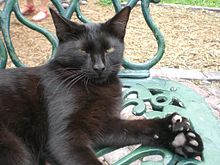Ernest Hemingway House
The residence was constructed in 1851 in a French Colonial style by wealthy marine architect and salvager Asa Tift.
[note 1] After the Hemingway's divorce and deaths, the house was auctioned off and subsequently converted into a private museum in 1964.
[2] Construction on the house began in 1848 and was completed in 1851[5] by Asa Tift, a marine architect and salvage wrecker, in a French Colonial estate style.
[6][8] In addition to the elevation, the house's 18-inch (46 cm) thick limestone walls protect it during tropical storms and hurricanes.
[9] In 1928, writer Ernest Hemingway and his wife Pauline Pfeiffer moved to Key West, where they spent the next three years living in rented housing, the last being a two-story home at 1301 Whitehead Street.
[16] The couple also converted the second story of the carriage house into a writing studio for Ernest and transformed the basement into a wine cellar.
With a melodramatic flourish, he threw a penny from his pocket onto the ground, declaring, "You might as well take my last cent," despite the fact that Pauline had paid for it herself.
[17] Despite his initial rage, the pool grew on Hemingway, and he later had a 6 feet (1.8 m) brick wall erected around the property so that he could swim nude.
After his death, a manuscript was discovered in a vault in the garage; this work was published posthumously in 1970 as Islands in the Stream.
These visitors include Hemingway's literary followers, historians, aficionados of the grounds and gardens, and the animal lovers who want to see the cats.
It would be upsetting if any of his houses were affected," she said, referring to Hemingway's properties in Havana, Cuba, and Ketchum, Idaho.
[33] The cats bear the names of celebrities, such as Humphrey Bogart or Marilyn Monroe, and have their own cemetery in the house's garden.
And because she was born while Hemingway was alive, we got to have a Betty White," since the actress was a pet enthusiast and animal welfare advocate.
Adding to the confusion, a photograph exists of a young Patrick and Gloria (Hemingway's daughter) playing with a white cat in Key West.
[34] Beginning in 2003, the museum was embroiled in a nine-year legal struggle against the United States Department of Agriculture (USDA) over whether the Animal Welfare Act of 1966, which typically regulates zoos and circuses with big cats, applied to the museum's six-toed feline population.
Ultimately, in 2012, the United States Court of Appeals for the 11th Circuit ruled that the Animal Welfare Act was applicable because the museum used cats in advertisements and sold cat-themed merchandise.



